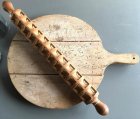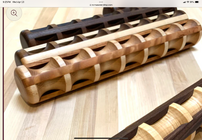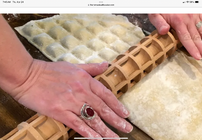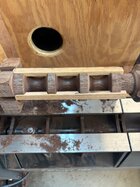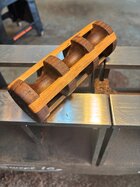-
November 2025 Turning Challenge: Wall Hanging! (click here for details) -
Congratulations to Craig Morton, People's Choice in the October 2025 Turning Challenge (click here for details) -
Congratulations to Andy Chen for "Mesquite Vase with Polymer Clay Millefiori" being selected as Turning of the Week for November 3, 2025 (click here for details) -
Welcome new registering member. Your username must be your real First and Last name (for example: John Doe). "Screen names" and "handles" are not allowed and your registration will be deleted if you don't use your real name. Also, do not use all caps nor all lower case.
You are using an out of date browser. It may not display this or other websites correctly.
You should upgrade or use an alternative browser.
You should upgrade or use an alternative browser.
Ravioli Roller
- Thread starter Henry Novak
- Start date
Looks like the struts lengthwise were inset into small dadoes cut in the blank. May be easiest to cut those in the blank prior to turning the core piece. Alignment of the spindle axis with the dado cuts will be very important.
I believe the slots for the longitudinal pieces should be cut on the table saw when the glue-up is square, however i would be concerned about tearout of these slots when turning on the latheLooks like the struts lengthwise were inset into small dadoes cut in the blank. May be easiest to cut those in the blank prior to turning the core piece. Alignment of the spindle axis with the dado cuts will be very important.
Yes, tearout would be a problem. One solution would be to leave the ends of the blank square so you will have a reference square to cut the slots. Then you could remount and finish turning the ends off the handle.
If you leave the blank long, you could build a C- shaped plywood sled and run wood screws through the ends into the finished turning and then cut the grooves on the table saw. Loosen the screws and rotate 90 degrees and repeat. If you turn between centers, you would have the centers marked in the blank to guide the wood screws and keep the turned blank centered. You would also want to measure the circumference and mark the 90 degree marks to index it in the fixture.
The best way that I can think of would be to turn the coves first, then cut the dados for the linear sticks.
Use a solid carbide down cut spiral of the required width and use a guide bushing in the router base.
Make a jig to guide the router similar to the sketch below.
Use the indexing on the lathe to position the work piece every 90 degrees

Use a solid carbide down cut spiral of the required width and use a guide bushing in the router base.
Make a jig to guide the router similar to the sketch below.
Use the indexing on the lathe to position the work piece every 90 degrees

john lucas
AAW Forum Expert
Even though im.a router guy and love.doing indexed projects I think the best way would be to use the table saw when it's still square. Use the toe of the skew to cut down the straight side then use a spindle gouge to cut the cove.
- Joined
- Apr 27, 2004
- Messages
- 9,295
- Likes
- 6,047
- Location
- Lakeland, Florida
- Website
- www.hockenberywoodturning.com
Everything mentioned will work with the appropriate spindle turning.
If I were to make it, I would use the first @Gary Beasley solution. It is the fewest steps and easiest setup.
I cut pommels frequently leaving square corners with no tearout.
A shear cut with a skew or a pull cut with a side ground bowl gouge will leave the edges of the dados crisp before cutting the coves. These edges will be dangerously sharp. If you touch the spindle with these sharp edges it would be like a 4 toothed saw.
I would also be making a final finish cut after gluing in the strips.
If I were to make it, I would use the first @Gary Beasley solution. It is the fewest steps and easiest setup.
I cut pommels frequently leaving square corners with no tearout.
A shear cut with a skew or a pull cut with a side ground bowl gouge will leave the edges of the dados crisp before cutting the coves. These edges will be dangerously sharp. If you touch the spindle with these sharp edges it would be like a 4 toothed saw.
I would also be making a final finish cut after gluing in the strips.
great ideas - I'm going to give it a try
Interesting. However, IMHO, to make pasta, ravioli, or something similar, it's easier to buy it ready made. My BIL bought a pasta maker and used it a few times and put it in the cabinet. I do want to make pierogie from scratch as I was told my grandmother made them. Pierogie (pee-ROW-hee) is an item similar to ravioli. They are made in Eastern European countries.
It's always better to make things yourself rather than to buy ready-made. Also, with a lathe nearby and growing hobby, it presents a challenge that most of us are up for !!Interesting. However, IMHO, to make pasta, ravioli, or something similar, it's easier to buy it ready made. My BIL bought a pasta maker and used it a few times and put it in the cabinet. I do want to make pierogie from scratch as I was told my grandmother made them. Pierogie (pee-ROW-hee) is an item similar to ravioli. They are made in Eastern European countries.
Has anyone in this crew made one?
I think it will be my next project.
Thinking about how, here is how I plan to go about it. Dado a grove on each side of a square blank. Turn the coves and then glue the strips. Then turn the assembly round. My question is best tool and spindle speed to avoid tear out. Also what wood would be best for the strips? First thought is cherry.
I think it will be my next project.
Thinking about how, here is how I plan to go about it. Dado a grove on each side of a square blank. Turn the coves and then glue the strips. Then turn the assembly round. My question is best tool and spindle speed to avoid tear out. Also what wood would be best for the strips? First thought is cherry.
Attachments
Once it’s done, send me the ravioli and I’ll tell you how well you did!
An interesting project. What does the resultant Pasta look like?
One favorite channel on You Tube is The Pasta Grannies. Worth the watch for making any kind of pasta. None of them ever use a roller like this. They all use a hand roller. place the fillings at regular intervals, fold the other half of the pasta dough over the top, hand press down a little, then use a hand roller to cut the lines. I need a good kitchen Island for rolling out pasta. I did make a matarello, about a 3 foot long straight rolling pin from maple and turned it down over about 3 months in stages. It makes it fairly simple to roll out large sheets of thin dough.
robo hippy
robo hippy
I would start with hard maple. Your plan sounds good to me. I would probably turn somewhere around 2000 rpm.Has anyone in this crew made one?
I think it will be my next project.
Thinking about how, here is how I plan to go about it. Dado a grove on each side of a square blank. Turn the coves and then glue the strips. Then turn the assembly round. My question is best tool and spindle speed to avoid tear out. Also what wood would be best for the strips? First thought is cherry.
It might be slick to have a protruding V, both on the strips and the flats between the coves, so it would cut the raviollis apart as you made them. 
Sounds like a really cool project. I hope you'll keep us posted about how it goes and how it works.
Sounds like a really cool project. I hope you'll keep us posted about how it goes and how it works.
Not the best video but may give you some ideas.
View: https://youtu.be/LguDSV8ufDI?si=n4ckjsgZve3npR4F
Since I’m extremely rusty and have some really nice blanks for projects, I decided to practice with a spindle gouge before working on the good stuff.
I said to myself, Self, why don’t you try to make a 3 row ravioli roller with a square made several weeks ago that had dado groves in it for such a purpose.
What I learned……the tear out due to the dado grooves being cut first was bad. Soooo, that piece became skew practice and I pretended I was Steve Jones wielding a skew with his deft touch. I can safely say I am not Steve but hey, it was time well spent. For those that want to give it a go, first turn a cylinder and coves but leave the ends square so you can cut the dados afterwards.
I’m waiting on the glue to dry and I’ll finish it up tomorrow. My question to the experienced turners, what would you use to finish turning to avoid tear out the cross pieces? The core is walnut and the cross pieces are pecan.
I said to myself, Self, why don’t you try to make a 3 row ravioli roller with a square made several weeks ago that had dado groves in it for such a purpose.
What I learned……the tear out due to the dado grooves being cut first was bad. Soooo, that piece became skew practice and I pretended I was Steve Jones wielding a skew with his deft touch. I can safely say I am not Steve but hey, it was time well spent. For those that want to give it a go, first turn a cylinder and coves but leave the ends square so you can cut the dados afterwards.
I’m waiting on the glue to dry and I’ll finish it up tomorrow. My question to the experienced turners, what would you use to finish turning to avoid tear out the cross pieces? The core is walnut and the cross pieces are pecan.
Attachments
I'm getting hungry reading all these posts of ravioli. So I'll get the wine and fork 
Cut the dados after turning the core.
Turn the core and leave the ends square, then cut the dados on a table saw or a router table.
Turn the core and leave the ends square, then cut the dados on a table saw or a router table.
That’s what I ended up doing. What tool would you use to do the final turning to finish it to reduce the risk of tear out on the strips?Cut the dados after turning the core.
Turn the core and leave the ends square, then cut the dados on a table saw or a router table.
Last edited:
First I would cut the strips from the straightest grain stock available, then use a skew to gently work them down.That’s what I ended up doing. What tool would you use to do the final turning to finish it to reduce the risk of tear out on the strips?

